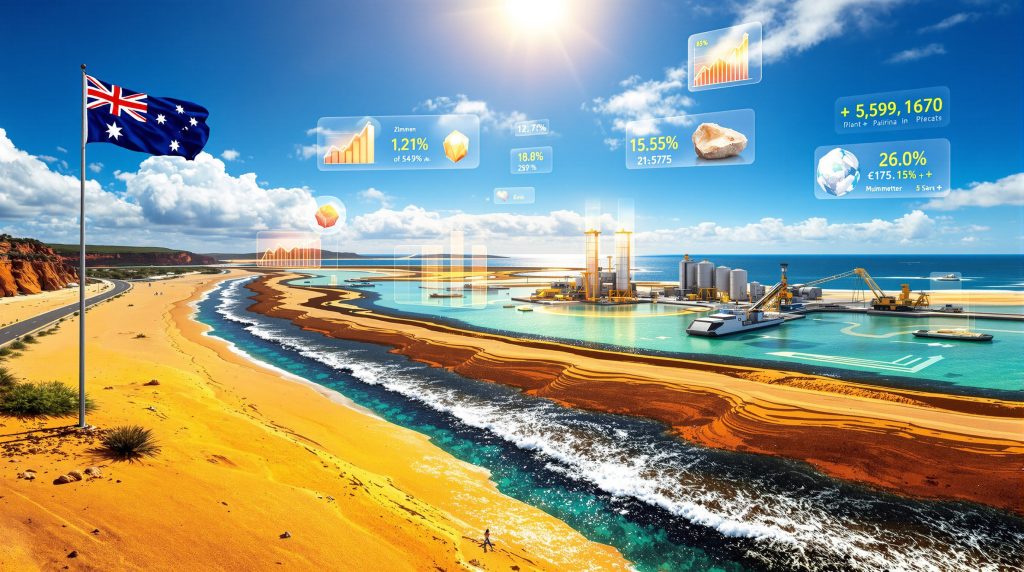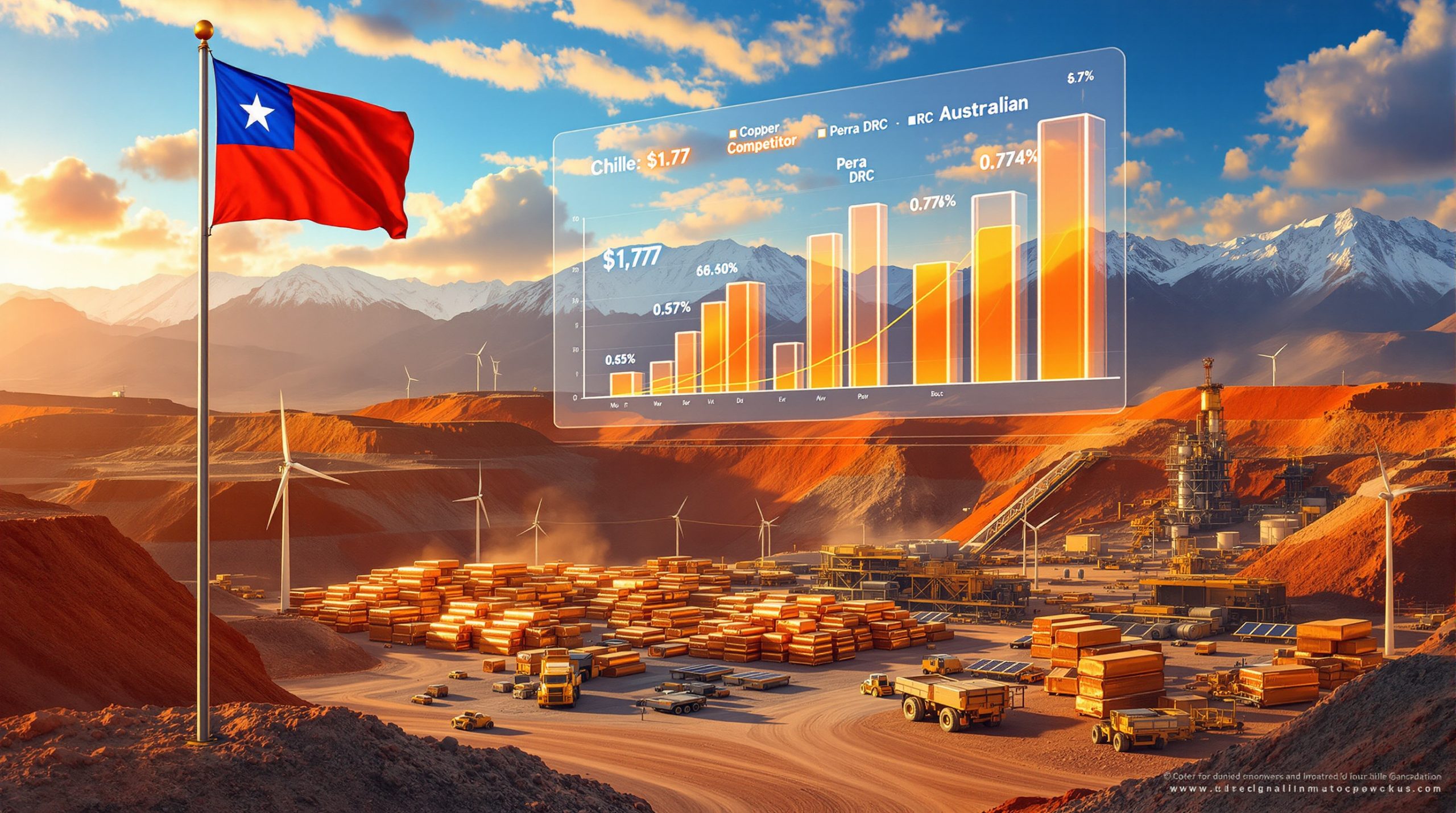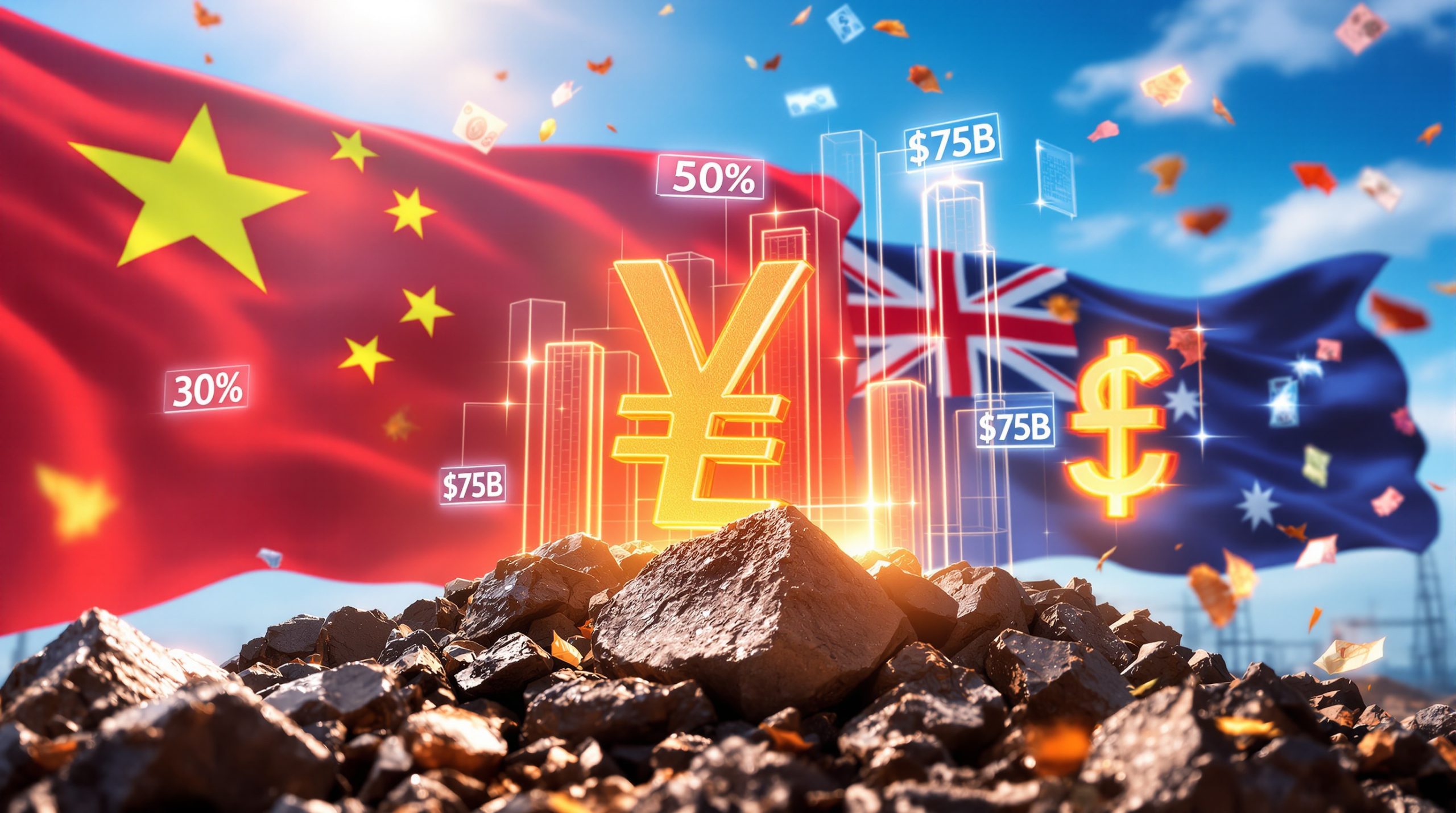Understanding Mineral Sands: A Strategic Investment Opportunity on the ASX
Mineral sands represent one of Australia's most strategically positioned commodity sectors, encompassing titanium-bearing minerals and zircon that serve as foundational materials across industries ranging from aerospace to consumer electronics. These specialised deposits contain ilmenite, rutile, leucoxene, and zircon – heavy minerals that have become increasingly critical as global supply constraints tighten against expanding industrial demand. For investors seeking exposure to this sector, mineral sands stocks on the ASX offer compelling opportunities through both established producers and emerging development projects.
Australia's dominance in this sector is remarkable, controlling approximately 68% of global zircon reserves and over 60% of world rutile reserves according to USGS data. This strategic positioning creates compelling opportunities for ASX investors as traditional supply sources face depletion and new project development remains capital intensive.
The mineral sands market differs fundamentally from base metals, operating through direct negotiations between producers and consumers rather than exchange-traded pricing. This opacity creates information asymmetries that astute investors can exploit, particularly when understanding the complex mineral deposit tiers and processing requirements that determine project economics.
Geological Formation and Geographic Distribution
Ancient Coastal Processes Create Modern Mining Opportunities
Mineral sands deposits originate through geological processes spanning millions of years, beginning with the weathering of igneous rocks containing titanium and zirconium minerals. Ocean currents and wind patterns naturally separate these dense minerals from lighter quartz sands along ancient shorelines, creating concentrated accumulations.
According to Geoscience Australia, these minerals initially crystallised in rocks such as basalt or granite before erosion transported them to coastal environments. The superior density of heavy minerals (typically 4-5 times that of quartz) enables natural concentration through hydraulic sorting processes.
Formation Characteristics:
- Beach environments with active wave sorting
- Inland deposits from historical sea level fluctuations
- Wind concentration through selective transport
- Depth variations from surface exposures to buried paleochannels
Strategic Geographic Distribution
| Region | Primary Resources | Reserve Estimates |
|---|---|---|
| Western Australia | Rutile, Zircon, Ilmenite | 60% of global rutile reserves |
| South Australia | Zircon-dominant assemblages | Jacinth-Ambrosia world's largest zircon mine |
| Victoria | Murray Basin resources | Multi-mineral assemblages |
| Queensland | Northern coastal deposits | High-grade rutile occurrences |
Mining Methodologies and Operational Considerations
Wet Mining versus Dry Mining Approaches
Mineral sands extraction employs two primary methodologies, each suited to specific geological and hydrogeological conditions. Furthermore, these mineral exploration techniques continue evolving with technological advancements.
Dredging Operations (Wet Mining):
- Artificial pond creation for continuous extraction
- Floating concentrators enabling immediate processing
- Higher water requirements limiting geographic applicability
- Reduced surface disturbance footprint
- Complex operational parameters requiring specialised expertise
Conventional Mining (Dry Mining):
- Traditional earthmoving equipment utilisation
- Predictable operating conditions across diverse climates
- Lower water dependency enabling broader geographic deployment
- Established rehabilitation protocols
- Cost-effective approach for most deposit configurations
The choice between methodologies depends on water table depth, seasonal variations, and regulatory requirements. Dry mining has become predominant due to operational flexibility and lower complexity, though wet mining offers advantages in specific geological settings.
Titanium Mineral Value Hierarchy and Market Dynamics
Understanding Grade-Price Relationships
The titanium mineral suite exhibits distinct value hierarchies based on titanium dioxide content and processing requirements:
Rutile (Premium Feedstock):
- 95%+ titanium dioxide content
- Direct feedstock for titanium metal production
- Limited global supply sources creating price premiums
- Current pricing: ~US$1,100-1,300/tonne
Leucoxene (Intermediate Grade):
- 65-90% titanium dioxide content
- Weathered ilmenite requiring beneficiation
- Bridge pricing between ilmenite and rutile
- Growing demand from specialised applications
Ilmenite (Base Grade):
- 35-65% titanium dioxide content
- Most abundant titanium mineral (89% of global supply per USGS)
- Requires upgrading for premium applications
- Foundation pricing: ~US$200-280/tonne
This grade hierarchy creates distinct market segments, with rutile commanding premiums due to processing advantages and titanium metal production requirements. Understanding these relationships is crucial for evaluating project economics and investment potential in the broader context of mining industry evolution.
Zircon Applications Beyond Traditional Markets
Expanding End-Use Markets Drive Demand Growth
While ceramic applications continue dominating zircon consumption at approximately 50% of global demand, emerging sectors are reshaping market dynamics:
Traditional Applications:
- Ceramic tile glazing and opacification
- Sanitaryware manufacturing providing opacity
- Refractory applications in steel and glass industries
- Foundry casting applications
Growth Markets:
- Electronics and semiconductor substrate applications
- Nuclear industry components leveraging corrosion resistance
- Advanced chemical processing catalysts
- Automotive catalytic converter components
- Medical device manufacturing
The integration of 3D printing technology in ceramics manufacturing is accelerating zircon consumption, while chemical applications demonstrate consistent 5-7% annual growth rates.
Iluka Resources reported that zircon chemicals consumption has expanded significantly, driven by electronics, communications, energy efficiency, and emission control applications. This diversification reduces dependence on traditional ceramic markets whilst creating premium pricing opportunities. Such trends highlight the importance of mineral beneficiation insights in maximising resource value.
Supply-Demand Fundamentals Shaping Investment Opportunities
Critical Supply Constraints Create Market Tightness
The mineral sands sector faces structural supply challenges that support favourable pricing dynamics:
Supply-Side Constraints:
- Limited new project development pipeline
- Existing mine depletion schedules across major producers
- Regulatory complexity in key producing regions
- High capital intensity deterring speculative development
Demand Growth Drivers:
- Urbanisation trends in emerging markets
- Infrastructure development programmes globally
- Aerospace sector expansion requiring titanium
- Electronics miniaturisation demanding specialised materials
Independent industry analysts TZ Minerals International predicted in February 2020 that average zircon pricing would reach US$1,480/tonne in 2021, growing to US$1,540/tonne in 2022 before moderating. Rutile was forecast at US$1,218/tonne in 2021 declining to US$1,138/tonne by 2024.
Current Market Pricing (2021 Data):
| Mineral | Grade Specification | FOB Australia Price |
|---|---|---|
| Rutile | 95% TiO2 minimum | US$740-1,100/tonne |
| Zircon | Premium grade | US$975-1,480/tonne |
| Ilmenite | 54% TiO2 minimum | US$173-260/tonne |
ASX-Listed Mineral Sands Investment Universe
Tier 1: Established Production Assets
Iluka Resources (ASX: ILU) – Market Leadership Position
Iluka Resources dominates ASX mineral sands exposure through its Jacinth-Ambrosia operation in South Australia (world's largest zircon mine) and Sierra Rutile operation in Sierra Leone (largest rutile mine globally). The company's mineral sands business generated $2.4 billion in free cash flow over 10 years through 2020.
During the first half of 2020, Iluka produced:
- 69,000t zircon and 10,000t rutile from Jacinth-Ambrosia
- 62,000t rutile from Sierra Rutile
- 23,000t zircon and 12,000t rutile from Cataby operations
Base Resources (ASX: BSE) – African-Focused Operations
Base Resources operates the Kwale mine in Kenya and is developing the Toliara project in Madagascar. The Kwale operation achieved its first full year of production from South Dune deposit in fiscal 2020, producing 78,920t rutile, 355,093t ilmenite, and 31,657t zircon.
The Toliara project completed a definitive feasibility study in late 2019, confirming ore reserves of 586Mt at 6.5% heavy minerals supporting an initial 33-year mine life. However, COVID-19 measures delayed final investment decision to September 2021 or later.
Tier 2: Near-Production Development Projects
Strandline Resources (ASX: STA) – Construction-Ready Asset
Strandline's Coburn project in Western Australia represents a construction-ready opportunity with an updated definitive feasibility study revealing NPV of $705 million. The company secured 72% of forecast revenue under binding offtake agreements and obtained a $150 million loan facility from Northern Australia Infrastructure Facility.
Production targeting before the end of September quarter 2022 positions Coburn to capitalise on anticipated supply tightness. The project benefits from established infrastructure and proximity to export facilities. For comprehensive coverage of mineral sands opportunities, investors should consider multiple development stages.
Sheffield Resources (ASX: SFX) – Joint Venture Structure
Sheffield's Thunderbird project in Western Australia's far north achieved a significant milestone through Yansteel's agreement to acquire 50% ownership for $130.1 million. This fully permitted project awaits final investment decision in 2021, with the joint venture structure providing development funding and operational expertise.
Tier 3: Exploration and Early Development Opportunities
Sovereign Metals (ASX: SVM) – Saprolite-Hosted Discovery
Sovereign's Kasiya deposit in Malawi represents a unique saprolite-hosted occurrence with rutile occurring within the top 8 metres of surface. Exploration results identified 16km of strike and widths up to 6km, with total mineralised footprint covering 66 square kilometres.
Recent assays revealed:
- 13m at 1.47% rutile including 4m at 1.71% rutile
- 8m at 1.08% rutile including 3m at 1.72% rutile
- 12m at 1.33% rutile including 5m at 1.64% rutile
Metallurgical test work generated 96% titanium dioxide product, indicating premium grade potential.
MRG Metals (ASX: MRQ) – Mozambique Exposure
MRG Metals secured highly prospective tenements in Mozambique, establishing a maiden resource of 1.42Bt at 5.2% total heavy minerals at Koko Massava within Corridor Central. The company targets operations with exceptional economics capable of profitability across market cycles.
Strategic positioning benefits from the proposed Chongoene Development Corridor project, featuring a 150Mtpa multipurpose deep water seaport only 10km from Corridor South's southern boundary. However, investors should note that mineral sands stocks on the ASX require careful evaluation of infrastructure access and development timelines.
Geopolitical Factors Influencing Investment Dynamics
Strategic Mineral Classifications Drive Policy Support
United States Critical Minerals Initiative:
The US designation of titanium minerals as critical materials creates policy support for domestic supply development. With 95% import dependency as of 2019 (increased from 74% in 2010), infrastructure stimulus programmes prioritise supply chain security.
US pigment production capacity reaches 1.37Mt annually compared to China's 3.25Mt and global 7.66Mt, indicating substantial domestic processing capability requiring feedstock security.
China Market Dynamics:
China dominates both titanium and zircon consumption as the world's largest tile manufacturer. The country's preference for ceramic floor coverings drives sustained demand, whilst 3D and automated tile printing technologies increase variety and volume requirements.
Iluka Resources noted that China's zircon chemical production and consumption leadership positions the country as a critical demand driver for specialised applications including electronics, communications, and emission controls. Furthermore, understanding global commodity market dynamics remains essential for investment decisions.
Australian Strategic Advantages:
- Stable regulatory environment with established mining codes
- Proximity to Asian consumption centres reducing transport costs
- Strong environmental, social, and governance standards
- Established port infrastructure facilitating exports
Environmental and ESG Considerations
Sustainable Operations Drive Competitive Advantages
Progressive Rehabilitation Requirements:
Mineral sands operations implement concurrent rehabilitation programmes, restoring mined areas to productive post-mining land uses. This approach minimises environmental footprint whilst creating long-term value through agricultural or conservation applications. The implementation of effective mine reclamation innovation ensures sustainable operations and regulatory compliance.
Water Management Systems:
Wet mining operations employ closed-loop water recycling systems, minimising freshwater consumption and environmental impact. Groundwater protection measures include monitoring programmes and engineered containment systems.
Carbon Footprint Optimisation:
- Energy efficiency improvements through technology upgrades
- Renewable energy integration where economically viable
- Transport optimisation reducing emissions intensity
- Processing technology advancement improving recovery rates
Technical Evaluation Criteria for Project Assessment
Resource Quality Metrics Driving Economics
Grade Assessment Parameters:
Investors should evaluate projects based on multiple grade criteria rather than total heavy mineral percentages alone:
- Total Heavy Mineral (THM) content: Baseline concentration metric
- Valuable Heavy Mineral (VHM) percentage: Economic mineral proportion
- Zircon-to-titanium ratios: Revenue optimisation indicator
- Overburden-to-ore ratios: Mining cost determinant
Processing Complexity Indicators:
- Mineral liberation characteristics affecting recovery
- Beneficiation requirements for product specifications
- Product quality capabilities meeting customer requirements
- Expected recovery rates across mineral species
Financial Modelling Benchmarks
| Assessment Metric | Tier 1 Projects | Development Assets |
|---|---|---|
| NPV/Capital Ratio | >2.0x | >1.5x |
| Internal Rate of Return | >20% | >15% |
| Capital Payback Period | <5 years | <7 years |
| Mine Life Expectancy | >15 years | >10 years |
Infrastructure Considerations:
- Transport distance to established port facilities
- Power supply availability and reliability
- Water access quality and sustainability
- Skilled workforce proximity and availability
Technology Trends Shaping Future Demand
Advanced Applications Creating Growth Vectors
Material Science Innovations:
Titanium and zircon applications continue expanding through advanced material development:
- High-performance ceramics for aerospace applications
- Semiconductor substrate materials for electronics
- Energy storage system components
- 3D printing materials for specialised manufacturing
Circular Economy Integration:
Technology advancement enables:
- Titanium recycling from aerospace and industrial applications
- Zircon recovery from ceramic and chemical processes
- Waste stream valorisation reducing primary demand
- Sustainable production methodologies improving efficiency
Digital Mining Technologies:
- Automated processing optimisation improving recoveries
- Real-time grade control systems enhancing selectivity
- Predictive maintenance reducing operational disruptions
- Remote operation capabilities improving safety and efficiency
Market Psychology and Investment Timing
Understanding Cyclical Demand Patterns
Historically, pigment demand correlates with GDP growth and exhibits seasonal patterns, with strongest demand during North American summer construction seasons. However, COVID-19 created unique dynamics where GDP declined globally whilst home renovation activity sustained paint demand.
The International Monetary Fund's October 2020 outlook projected global GDP contraction of -4.4% in 2020, followed by 5.2% growth in 2021. Australia's Reserve Bank expected domestic 4% contraction in 2020 and 5% growth in 2021.
Despite GDP volatility, mineral sands pricing erosion remained moderate compared to historical downturns, indicating market maturation and supply discipline. Post-COVID infrastructure and military stimulus programmes are anticipated to drive demand, particularly in the US and China.
The mineral sands stocks on the ASX sector's resilience during 2020 market disruption, combined with structural supply constraints and expanding applications, positions these investments as compelling opportunities. Consequently, investors seeking exposure to critical materials with favourable supply-demand fundamentals should consider the diverse range of mineral sands stocks on the ASX across development stages and geographic exposures.
Could the Next Mineral Sands Discovery Be Your Pathway to Returns?
Discovery Alert's proprietary Discovery IQ model continuously scans ASX announcements to identify significant mineral discoveries, including emerging mineral sands opportunities that could transform into the next major investment story. Discover why historic discoveries like those by De Grey Mining and WA1 Resources have delivered substantial returns by exploring our dedicated discoveries page and begin your 30-day free trial today to position yourself ahead of the market.




